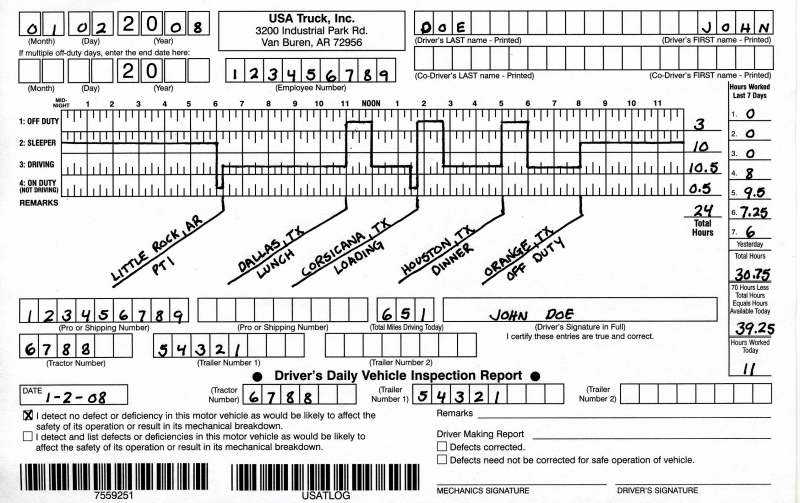Truck-trailer Accidents – Getting to the basics
Those involved in trucking litigation have become all too familiar with catastrophic injury and loss of life resulting from 18 wheelers (tractor trailers) being operated by drivers impaired by chronic fatigue.
Why do we continue to see this problem?
In the case of a professional commercial truck driver who rear ends a stopped line of other vehicles, there can be only one of two explanations:
- Either the driver did it intentionally because, unless he was impaired, he could not help but see it, and if he did it intentionally, he’s guilty of murder; or
- He was so impaired he never recognized a long line of cars stopped ahead of him in broad daylight with no view obstruction with plenty of time to stop.
The financial incentive for trucking companies and drivers to keep a tractor-trailer unit (profit unit) in operation all hours of the day and night is significant and not expected to diminish. The U.S. Department of Transportation Federal Motor Carrier Safety Administration administers hours of service rules for drivers and trucking companies (49 C.F.R. Code Part 395), but with its practical limitations in enforcement ability, it is, at best, a moderate deterrent to chronic violations resulting in fatigued, dangerous drivers behind the wheel.
In any instance involving the tragic loss of life or serious injury in commercial truck collisions, extensive discovery is required and one of the critical areas focuses on proof of hours of service violations. It then focuses on how the proof of chronic violation of hour of service safety regulations can provide the basis for proof not only of negligence, but punitive damages against the company and driver.
Where the driver’s log and grid show 3.5 hours driving time, but shows a route of 300 miles being covered, one can conclude:
- The driver has lied about the time he spent driving, or
- The driver was flagrantly speeding throughout his route (a truck obeying speed limits on highways will average 50 miles in an hour).
Where a driver’s log and grid shows a 24-hour period of duty and begins with “driving” as the first entry, the driver has probably cheated on listing his duty time. It usually takes from 30-60 minutes for a driver to report to duty to the yard, get all of his paperwork, inspect his load, and perform the required inspections on his rig.
Where a driver logs 11 hours of driving time for the preceding 24-hour period and fails to get or log 10 solid hours of “off duty” time before resuming duty and driving, all of his driving for the following day is illegal and in violation of the safety regulations set forth in 49 C.F.R. 395.3.
Time and location of sequential fuel receipts can be important in showing the impossibility of compliance with the hours of service regulations in 49 C.F.R. 395.3.
Discovery regarding hours of service should be conducted with the suspicion that hours of service have been violated and records of driver’s duty status have been falsified until proven otherwise. Discovery of the following documents helps cross reference criteria to check for validity or invalidity of driver’s duty hours:
- Driver’s log as required by 49 C.F.R. 395.8 for the day of the collision.
- Driver’s logs for defendant driver for the 6 months preceding the collision in question.
- Graph Grid required by 395.8 (g) for that day and for the 6 months preceding the collision.
- Records of automatic on-board recording devices required by 49 C.F.R. 395.15 for the day of the collision and the 6 months preceding.
- All payroll, or payment logs, or records for that driver for the time period, including the collision and 6 months prior thereto.
- All W-2’s for the driver in question for the withholding period, which includes the collision in question, and all reporting periods for 6 months prior thereto.
- All fuel receipts incurred from the time the truck left the carrier’s premises until the time of the collision.
- All Bills of Ladings and manifests pertaining to property transported and/or delivered from the time the truck left the carrier’s premises until the time of the collision.
Many times a driver and company’s violation of hours of service regulations fall into a pattern. Examination of the logs and data for the prior 6 month period will help to reveal those patterns. Where such patterns exist, they are a flagrant disregard of safety regulations.
49 C.F.R. Part 395 protects the public from the hazard of fatigued drivers operating huge trucks in their midst. The hours of service regulations have been written from the blood of innocent citizens massacred by huge trucks at the hands of drivers impaired from fatigue. Where a driver and carrier intentionally violate the safety regulations designed to guard against fatigue, they have shown a conscious disregard for the safety of the public using our highways. Where such a fatigued driver has caused injury or death, the driver and carrier have acted with conscious and reckless disregard for the life and safety of the public on the highways. This conduct justifies a punitive damage award against them, in addition to compensatory damages.
Share This



